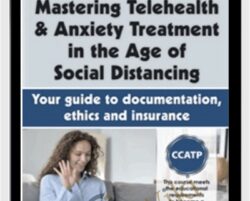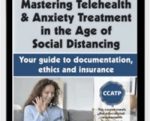Your clients need you in these times more than ever.Anxiety is flooding their lives as they worry about loved ones, health, finances, stability and futures.But your ability to safely and responsibly work with clients in-person has been drastically altered. In many cases, therapy has completely halted for those who desperately need it. And it could stay that way for days, weeks and possibly months.If you’ve never worked with telehealth or considered providing distance therapy services, now is the time.You may have questions…What are the legal and ethical risks? Is distance therapy even effective? How do I get started?Certified Clinical Telemental Health Provider, Joni Gilbertson, has answers.Filled with best practices, case studies, and treatment adaptations for working virtually, her new intensive online certification training provides the education you need to confidently and competently offer safe, effective telehealth services to your clients — allowing you to work from a variety of settings, including your home or office.PLUS… Joni has been joined by leading anxiety treatment specialist Catherine M. Pittman, Ph.D., HSPP, for a comprehensive look at how you can use neuroscience to inform why, how and what techniques will stop the symptoms of anxiety — even the tough to treat panic attacks, worry, rumination, nausea, and pounding hearts.Completely online and self-paced, you can view this comprehensive certification training whenever and wherever the time is right.Once you complete this training you’ll immediately qualify to become a Certified Clinical Telemental Health Provider PLUS a Certified Clinical Anxiety Treatment Professional (CCATP). Expand your client reach and build a better professional future with this online training!Work with clients without leaving your homeGain access to clients practicing social distancing or remote clientsGrow your practice in troubling economic timesBecome a Certified Clinical Telemental Health ProviderBecome a Certified Clinical Anxiety Treatment ProfessionalWork with anxiety more effectively than ever before in a world full of uncertaintyPractice within your boundaries of competence when using technologyGain competency in the legal and ethical requirements associated with privacy, security and crossing state linesLearn how to adapt use for various populations and disordersProtect yourself from common privacy violations when texting or emailing clientsGet Mastering Telehealth & Anxiety Treatment in the Age of Social Distancing: Your guide to documentation, ethics and insurance – Catherine M. Pittman & Joni Gilbertson, Only Price $79Part 1 | Certified Clinical Telemental Health Provider TrainingYour complete guide to distance therapy! Filled with best practices, case studies, and treatment adaptations for working virtually, this intensive training will provide you the education you need to confidently and competently offer safe, effective telehealth services to your clients — allowing you to work from a variety of settings, including your home or office.Telehealth for Mental Health Professionals: What You Need to Know Before You Get StartedThe Types of TelehealthSynchronous Format – Live Interaction via VideoAsynchronous Format – Transfers of Information ElectronicallyEvidence Supporting the Effectiveness of Telehealth for Clients and Various PopulationsThe Benefits and Risk for TelehealthRecent Trends in TelehealthLegal & Ethical IssuesFollowing a Code of EthicsLegal Implications of Practicing Across State LinesPrivacy & SecurityHIPAA Compliance ConcernsDocumentation & Paperwork IssuesEnsure Data Protection & Avoid Unintended Access/DisclosureThe Client’s Perception of Privacy via VideoconferencingBoundary Issues More Likely to Arise in TelehealthMulticultural Issues in TelehealthTechnology Competence of the Clinician and ClientHow to Start Your Mental Health TelepracticeOffering Your Telehealth Services – Where to Begin?How to Introduce the Concept to ClientsWho is a Good Fit for Telehealth? Who is Not?Administrative ResponsibilitiesPolicies & Procedures Consideration – Protect Yourself and Your LicenseInformed Consent – Unique Concerns & Best PracticesIntake Process – Tips You Need to KnowEmergency Plan for TelehealthClient Interviewing & Assessment TechniquesVideoconferencing vs. TelephoneBest Practices for ProfessionalismCamera Placement, Background, Proximity & Dress AttireHandling Technical IssuesImportant Business Aspects to ConsiderMarketing Concerns with Telehealth PracticeBilling & Reimbursement Strategies – Is This Covered Under My Client’s Insurance Policy?Payment Fee Structure ConsiderationsCommunication of Payment Structure to ClientProfessional Liability Insurance – Telehealth Covered?Client Expectations & How They Differ Versus In-Person TherapyFinancial, Accounting & Tax ConcernsGiving and Getting Referrals – Issues for TelepracticeChoosing a Platform: What Technology is Right for You and Your Clients?An Overview of the Various Platforms AvailableDemonstrations of Key FeaturesHow to Assess What Features are Important for YouCost ComparisonsWhat Legal Assurances Do I Need from A Platform Provider?Client Considerations When Choosing a PlatformWhat Technology is My Client Using & Where From Demonstrations of Telehealth in PracticeA Guided Tour of How to Begin a Telehealth Videoconferencing SessionWhat Videoconferencing Looks Like in PracticeKey Techniques to Enhance the Telehealth In-Session ExperiencePresentation Skills & TipsAdditional Technology ConsiderationsText Message & Email Telehealth – Security, Privacy & ExpectationsCloud Storage – What are the legal issues?Virtual Reality – What You Need to KnowTreatment Adaptations to Consider for TelehealthDisordersDiscuss Key Adjustments Recommended for Practicing Telehealth for Different DisordersPopulationsEvidence & Best Practices for Tailoring Telehealth to a Variety of ClientsImportant Adaptations for Groups or CouplesModalitiesWhich Modalities Most Easily Apply to Telehealth & Which Could Use AdaptionsThe Future of Telehealth for Mental Health ProfessionalsPossible Future New Rules & RegulationsUp & Coming Technology Trends to Be Aware OfWhat Distance Therapy Might Look Like in 10 yearsGet Mastering Telehealth & Anxiety Treatment in the Age of Social Distancing: Your guide to documentation, ethics and insurance – Catherine M. Pittman & Joni Gilbertson, Only Price $79Part 2 | Certified Clinical Anxiety Treatment Professional (CCATP) TrainingIn Part 2, you’ll see how neuroscience can inform why, how and what techniques can help your clients stop the symptoms of anxiety — even the tough to treat panic attacks, worry, rumination, nausea, and pounding hearts.More than just the neurobiological “whats and whys,” you’ll also learn the “hows” of actual treatment — so you’ll know exactly how to empower your clients with strategies to resist anxiety-igniting cognitions and find deep, lasting relief from panic, worry, trauma and obsessions.Using Neuroscience in the Treatment of AnxietyHow does Neuroscience inform the clinical treatment of anxiety? In Module one, you will explore the neurological processes behind anxiety. You’ll also learn…How you can help your anxious clients understand their own symptoms, feelings, interpretations, beliefsWhat to do when treatment strategies for anxiety produce anxietyHow to work within the goal of changing the brain rather than the goal of reducing anxietyHow neuroplasticity makes the brain more resistant to anxietySimple explanations you can share with clients about how anxiety travels through their brainWorking with the AmygdalaYou’ll learn how the amygdala fuels anxiety and how amygdala management can improve your client’s level of functioning without the use of medication.Why amygdala management is essential for all Anxiety Disorders, PTSD, OCD, DepressionThe amygdala’s role in the stress/fear/anxiety response and formation of emotional memoriesHow to train the brain to stop responding to negative anxiety “triggers”The Vagus nerve’s role in recovery from the activation of the sympathetic nervous systemInterventions that reduce anxiety “fuel” produced in the amygdalaUsing exposure: safely activating the fear circuitry created in the amygdala to generate new connectionsManaging the CortexThe brain’s cortex plays an “anxiety igniting” role in many anxiety disorders, including: GAD, SAD, OCD, PTSD and also depression, eating disorders and substance abuse. In Module 3, you’ll learn tools and strategies for recognizing and managing anxiety driven by the cortex. You’ll also learn…How the cortex constructs realityHow to resist the effects of anticipation and the healthy (adaptive) use of worry“Survival of the busiest” principle — strengthen or weaken specific circuitryHow to recognize and modify the impact of uncertaintyLeft hemisphere techniques: How to use cognitive defusion, coping thoughts, and fighting anticipationRight hemisphere techniques: How to use imagery and musicMedications in the Treatment of AnxietyEven when you don’t prescribe medications, it’s important to understand how medication impacts your treatment plan. In this module, you’ll learn how your partnership with prescribers can improve overall client education on how medication affects clients and their therapeutic goals.The myth of the chemical imbalanceTools for assessing medication use during the initial intakeHow SSRIs and SNRIs promote neuroplasticityThe danger of sedating the brain with benzodiazepinesAn overview of buspirone, beta blockers and sedatives/hypnotics/z-drugsThe effectiveness of CBT and medsExposure Strategies for Teaching the AmygdalaUsing exposure can help teach the brain new, positive ways to respond. In this module, you’ll learn to safely and effectively use exposure strategies to create new emotional learning.Tools for helping clients learn to reduce avoidance and push through anxietyHow to prepare clients for exposure: psychoeducation, breathing training, cognitive restructuringIn vivo vs. imaginal exposure approachesInteroceptive triggers and methods for exposureUse of Subjective Units of Distress/Discomfort Scale (SUDS)Concerns associated with safety signals, medications, distractionHow to troubleshoot problemsMindfulness in the Anxious BrainOur clients with anxiety or depression may be so paralyzed with worry or rumination that they aren’t aware of their experiences. When we introduce Mindfulness to the anxious brain, we provide an evidence-based avenue for changing the brain to be more resistant to anxiety and its symptoms.Defining basic emotional reactions: Attachment, Aversion, IndifferenceHow to practice self-acceptance and erase the detrimental effect of judgmentUsing mindfulness to explore thoughts, sensations, and emotional reactionsHow to use the power of intention to focus thoughts in new directionsTools for coping with common reactions to aversionUsing Neuropsychologically Informed CBT InterventionsIn this module, you’ll work on increasing the effectiveness of CBT tools by using neurologically informed interventions. You’ll learn exactly what to do to use this skills-based approach to help your clients practice new behaviors and strengthen new neural connections to ease their anxiety.Using CBT and neurological knowledge to strengthen client engagementAdvantages of the strategic use of neuroscience in CBTWhy focusing on logic and disputing has limitsUsing skills-based approaches in CBT to provide the brain experiences to learnTreating Comorbid DepressionWith some estimates showing that 60% of those with anxiety will also have symptoms of depression, you are likely treating individuals for both disorders. In this module, you’ll explore the link between anxiety and depression and learn how you can more effectively improve both disorders through interventions that help make the brain more resistant to anxiety and depression.How the hippocampus impacts negative thinkingExercises to help clients focus on the positiveAddressing worry, rumination, and common cognitive errors in depressionBenefits of goal setting and behavioral activationKey role of social support and social interactionCognitive Restructuring InterventionsWhen clients have obsessive, ruminative and worry-based thinking, clinicians can easily get caught up in the process. In module 9, we’ll cover effective approaches for working with OCD and GAD that ensure we don’t co-obsess.How to challenge distorted thoughts and unrealistic beliefs and imagesHow to identify and stop anxiety-igniting thoughts common in OCD and GADStrategies for helping clients embrace uncertainty Making OCD or worry the adversary: Don’t be bullied!Why clients should schedule obsessions or worries to bring them under controlUsing Reconsolidation ApproachesBreakthrough research shows we can modify and erase old memories through reactivation – which can reduce anxiety symptoms quickly. In this final module, you’ll explore step-by-step how to safely use therapeutic memory reconsolidation to improve anxiety treatment.Explaining implicit emotional learning and identifying examplesHow to assist the client to experience the memory structure in the present momentHow to promote your client’s experiential learning of emotional truthSteps for disconfirming the emotional memory with “mismatching” information that invalidates itRegister today and get these FREE bonuses!Bonus 1: Your first FREE Bonus item Bonus Q&A Call RecordingIn this exclusive Q&A call recording, Catherine Pittman, Ph.D., HSPP, addresses questions directly from course attendees and shares additional insight into improving therapeutic outcomes with anxious clients.Bonus 2: Your second FREE Bonus itemYour CTMH certification application fee is FREECertification made simple! Register today and pay no additional fees to complete your Clinical Telemental Health Provider (CTMH) certification.Bonus 3: Your third FREE Bonus item Your CCATP certification application fee is FREECertification made simple! Register today and pay no additional fees to complete your Certified Clinical Anxiety Treatment Professional (CCATP) certification.Bonus 4: Your fourth FREE Bonus item FREE 1-year Certified Provider Registry ListingGet your name and Certification in front of millions of people – many who are looking for a Clinical provider to support their mental health in these uncertain times.Bonus 5: Your fifth FREE Bonus itemFree Peer Support GroupWorried you won’t know what to do once you get started? We have created an online community of Certified Clinicians who are going through the same things you are. You’ll have 24/7 access to post your questions, respond with your own experiences, and simply connect with others. Get Mastering Telehealth & Anxiety Treatment in the Age of Social Distancing: Your guide to documentation, ethics and insurance – Catherine M. Pittman & Joni Gilbertson, Only Price $79Tag: Mastering Telehealth & Anxiety Treatment in the Age of Social Distancing: Your guide to documentation, ethics and insurance – Catherine M. Pittman & Joni Gilbertson Review. Mastering Telehealth & Anxiety Treatment in the Age of Social Distancing: Your guide to documentation, ethics and insurance – Catherine M. Pittman & Joni Gilbertson download. Mastering Telehealth & Anxiety Treatment in the Age of Social Distancing: Your guide to documentation, ethics and insurance – Catherine M. Pittman & Joni Gilbertson discount.
Mastering Telehealth & Anxiety Treatment in the Age of Social Distancing: Your guide to documentation, ethics and insurance – Catherine M. Pittman & Joni Gilbertson
₹12,450.00







